North American orioles belong to the genus Icterus in the blackbird family (Icteridae). Eight species occur regularly in the United States and Canada, while several others appear as occasional migrants, vagrants, or rare breeders along the southern border. In this article, we move from the most common and widespread to the rarest, highlighting their plumage, calls, and key traits to help distinguish them in the field.
Baltimore Oriole
Icterus galbula
- Identification: Medium-sized oriole, males bright orange with black head and white wingbar; females duller yellow-orange with olive-brown tones.
- Where found: Breeds across eastern and central North America; winters in Mexico, Central America, and northern South America.
- How to spot: Look for vivid orange males singing from treetops, or listen for their clear, flute-like whistles.
- Conservation status: Least Concern globally, but showing long-term population declines due to habitat loss, pesticides, and migration hazards.
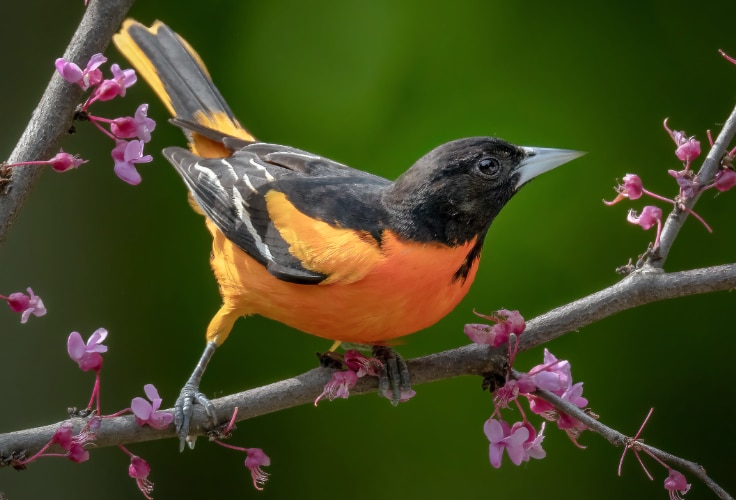
The Baltimore oriole is the most widespread oriole in eastern North America and one of the most recognizable birds of the region. Famous for its vivid orange-and-black plumage and rich, whistling song, it is a familiar sight in parks, gardens, and forest edges each spring and summer. Measuring 17-20 centimeters (6.7-7.9 inches) in length, it is a medium-sized songbird with a slender build, long wings, and pointed bill.
Adult males are strikingly patterned, with black head, back, wings, and tail contrasting against brilliant orange underparts and shoulders. They show a bold white wingbar and flashes of orange in the tail. Females are highly variable, ranging from pale yellowish-orange with olive-brown wings and tail to more orange, male-like birds. Young birds resemble females in their first year before maturing into adult plumage after their second molt.
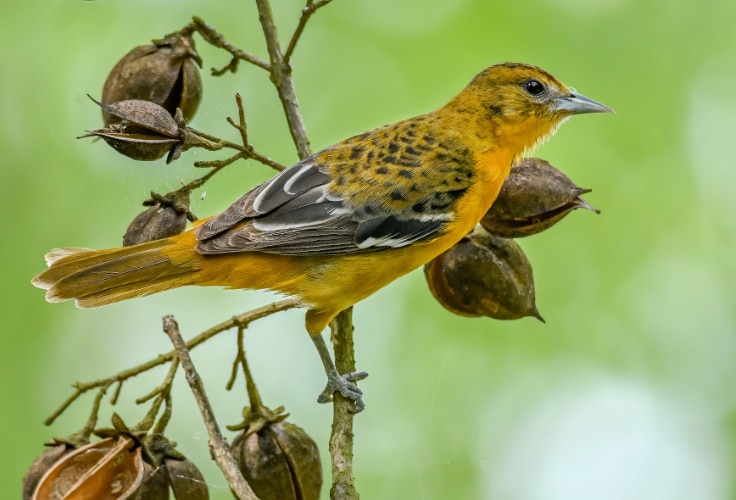
Baltimore orioles are agile and active, often spotted foraging among the treetops where they hop, flutter, and even hang upside down to reach insects or fruit. They are more often heard than seen, with males singing loud, flute-like phrases from exposed perches. Both sexes give a chattering call, and during courtship males perform wing-spreading displays while females respond with tail-fanning and calls. At feeders, they are drawn to oranges, grape jelly, and nectar, often allowing close views.
This species breeds in open deciduous habitats with tall trees, particularly along rivers, forest edges, and in towns or parks. Its range extends from southern Canada east of the Rockies southward through most of the eastern United States. In winter, it migrates long distances to Mexico, Central America, and northern South America, also reaching the Caribbean. Nests are intricately woven hanging pouches, usually placed high in isolated trees. During the breeding season, Baltimore orioles eat mostly insects, caterpillars, and spiders, while in winter they shift to nectar and small fruits.
Despite being common and adaptable, Baltimore orioles show long-term declines across much of their range. Populations have decreased by more than a third since the late 20th century. Habitat loss on both breeding and wintering grounds, pesticide use that reduces insect prey, and threats during nocturnal migration, such as collisions with glass and towers, are all concerns. Nevertheless, they remain widespread and are readily supported by backyard plantings and feeders, making them one of the most familiar migratory songbirds of North America.
Orchard Oriole
Icterus spurius
- Identification: Small, short-tailed oriole; males chestnut and black, females and immatures yellow-green with white wingbars.
- Where found: Breeds across eastern and central North America; winters in Mexico and Central America.
- How to spot: Look for chestnut males or yellow-green females in open woodlands, especially near rivers; listen for rapid, musical robin-like whistles.
- Conservation status: Least Concern globally, though declining in parts of its range due to habitat loss, grazing impacts, and brood parasitism.

The orchard oriole is the smallest North American oriole and unique for the chestnut coloration of its adult males. Unlike the bright orange Baltimore oriole, it shows a darker, more subdued plumage but is equally notable as a widespread breeder in open and semi-open habitats across the eastern and central United States. Measuring 15-18 centimeters (5.9-7.1 inches), it is slender with a relatively short bill and tail compared to its close relatives.
Adult males are easily recognized by their black head, back, wings, and tail contrasting with rich chestnut underparts and rump. Females and juveniles appear entirely different, showing olive-green upperparts and yellow underparts with two narrow white wingbars. Young males often resemble females in their first year, gradually developing a black throat and chestnut feathers before attaining full adult plumage.
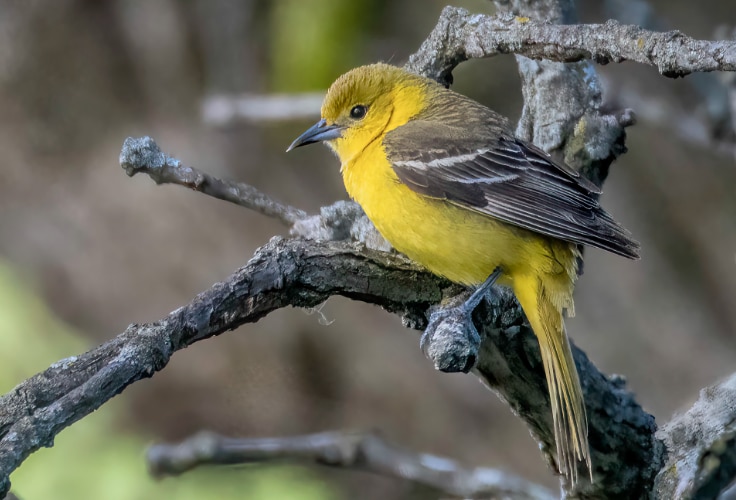
Orchard orioles are active and light in flight, often foraging low in trees, shrubs, and even tall grasses. Their rapid wingbeats give them a buoyant, sparrow-like flight style, and they usually stay at or below treetop level. They forage by gleaning insects and spiders, hanging acrobatically to reach flowers and leaves, or darting after flying prey. During breeding season, both males and females sing – a rapid, musical series of whistles interspersed with harsher notes, often compared to the American robin but shorter and livelier. Calls include a soft jeet and rapid chatter typical of orioles.
This species prefers open landscapes, favoring riparian woodlands, forest edges, orchards, parks, and agricultural fields with scattered trees. It breeds from the southern Great Plains eastward across the Midwest and Atlantic states into southern Canada. In winter, it migrates early, leaving breeding grounds by midsummer, and travels to Mexico, Central America, and occasionally as far as northern South America. Nests are pouch-like structures suspended from branches, and while usually monogamous for a season, pairs change annually. The diet shifts seasonally from insects during breeding to fruits and nectar in migration and winter.
Although still fairly common, orchard oriole populations have been declining steadily over the past 50 years. Loss of riparian woodlands, grazing pressure that removes shrub cover, and increased cowbird parasitism have negatively affected local populations, especially in the southern U.S. and along the Rio Grande. Wintering habitat is also threatened by agricultural clearing in Central America. Despite these challenges, the species adapts well to some suburban habitats and remains widely distributed, though careful habitat management is needed to support long-term stability.
Bullock’s Oriole
Icterus bullockii
- Identification: Medium-sized oriole; males orange with black crown, throat, and eyeline, large white wing patch; females dull gray-yellow with orange face.
- Where found: Breeds across the western U.S. and southern Canada; winters throughout Mexico and into Guatemala.
- How to spot: Watch for bright males in riparian cottonwoods or open woodlands; listen for their musical, warbled song with sharp notes.
- Conservation status: Least Concern globally, but declining due to riparian habitat loss, irrigation pressures, and pesticide impacts.
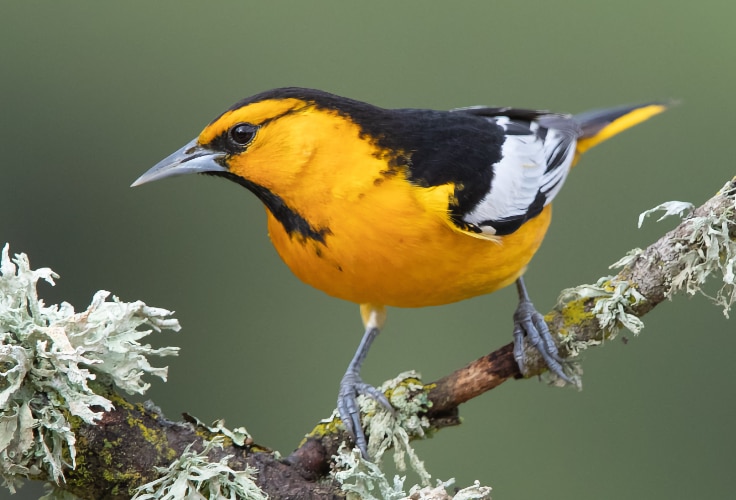
Bullock’s oriole is the western counterpart to the Baltimore oriole, and together the two form a hybrid zone across the Great Plains. It is one of the most familiar and colorful songbirds of the American West, often spotted in cottonwood-lined rivers and open oak woodlands. Males measure 17-19 centimeters (6.8-7.6 inches) and are strikingly patterned, while females are slightly smaller and more subdued in appearance.
Adult males have a vivid orange face, breast, and underparts, contrasting with a black crown, eyeline, throat, and back. Their white wing patch is broad and distinctive, setting them apart from other orioles. Females and immatures are much duller, showing grayish upperparts, pale underparts washed with yellow or orange, and faint wingbars. Young males resemble females in their first year, gradually acquiring black on the throat and brighter orange on the face before maturing fully.
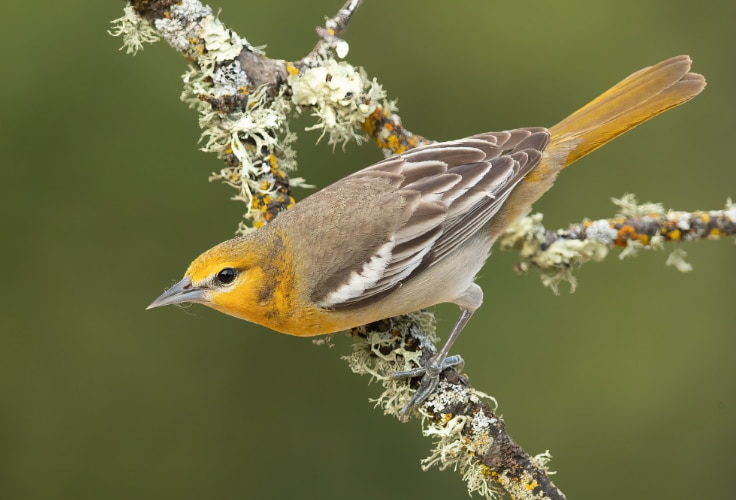
Bullock’s orioles are agile and active, often hanging upside down to probe flowers or leaves for insects and nectar. Their flight is strong and direct, and during migration they may form small, loose flocks. Males display with bows and hopping motions while singing loudly, showing off their bright plumage. Females also sing, usually near the nest, while both sexes give chatter calls and alarm rattles. Pairs remain together through the breeding season, defending nests cooperatively against predators such as squirrels, jays, and crows.
This species breeds widely across the western United States, from southern British Columbia and the northern Great Plains south through California, Arizona, New Mexico, and Texas, and into northern Mexico. It favors riparian woodlands with large cottonwoods, sycamores, or willows, but also nests in oaks, pecans, mesquites, and even ornamental or eucalyptus trees in towns and parks. In late summer, many migrate through the Mexican Monsoon region to molt before continuing south. Wintering occurs throughout Mexico and locally in Guatemala, where they occupy a wide range of wooded and open habitats, including shade coffee plantations and urban areas.
Though still widespread and fairly common, Bullock’s orioles have declined steadily over the past half-century. Habitat loss from river alteration, groundwater depletion, and grazing has reduced suitable breeding areas. Pesticides both diminish insect prey and can directly harm birds. Despite these pressures, the species remains resilient, adapting to altered landscapes and using both natural and human-modified habitats. Ongoing conservation of riparian woodlands is essential for maintaining stable populations across the West.
Hooded Oriole
Icterus cucullatus
- Identification: Slender, medium-sized oriole; males orange to yellow-orange with black throat and mask, white wing patch; females duller yellow with grayish tones.
- Where found: Breeds in the southwestern U.S., Mexico, and parts of Belize; winters in Mexico. Expanding northward, especially in California.
- How to spot: Look for males in palm trees and suburban yards; listen for soft chatter and faint songs often given from inside foliage.
- Conservation status: Least Concern globally; populations stable or increasing overall, but declining in Texas due to cowbird parasitism.
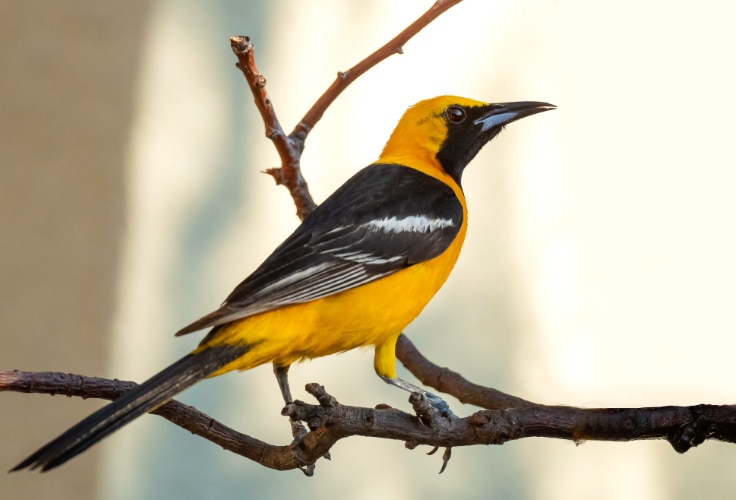
The hooded oriole is among the most graceful North American orioles, with a delicate build, long tail, and slender, decurved bill. It is notable for its strong association with palm trees, which have allowed it to expand its range in recent decades, particularly in California where ornamental plantings provide ideal nesting sites. Measuring 18-20 centimeters (7.1-7.9 inches), it is medium-sized but slimmer and more elongated than other orioles.
Adult males are striking, with bright orange to yellow-orange head, nape, rump, and underparts, a black bib and eyeline, and contrasting black wings and tail. They show bold white wingbars and a white-edged tail. Females are much duller, olive-yellow overall with grayish upperparts and less vivid underparts. Immature males resemble females but carry a partial black throat and mask, gradually attaining full adult plumage.

These orioles forage methodically, probing flowers and foliage for insects and nectar. They are acrobatic, often hanging upside down from leaves, and occasionally visiting hummingbird feeders. Their flight is quick and direct, and while males sometimes sing, the song is quieter and less conspicuous than that of other orioles. Both sexes chatter frequently, and males perform sleek, upright displays with bill pointed skyward during territorial disputes. Courtship involves bowing and wing fluttering as males approach females.
The hooded oriole breeds across the southwestern United States, from California and Nevada through Arizona, New Mexico, and Texas, and southward through Mexico into Belize. It is most often found in open woodlands, desert oases, riparian areas, and increasingly in urban parks and neighborhoods where palms, cottonwoods, or sycamores are present. Nests are suspended from the undersides of palm fronds or leafy branches. The species winters mainly in Mexico, though some linger in southern California, Arizona, and Texas. Its diet consists of insects, spiders, nectar, and fruit, often taken from tubular flowers by piercing the base.
Populations of the hooded oriole are considered stable or increasing overall, aided by its adaptation to ornamental plantings and feeders. However, regional declines are documented in Texas, particularly in the lower Rio Grande Valley, where cowbird parasitism heavily impacts nesting success. Habitat change and urbanization have created both challenges and opportunities, but for now the species remains widespread and locally common across much of its range.
Scott’s Oriole
Icterus parisorum
- Identification: Medium-sized oriole; males with black head, back, and breast contrasting with bright lemon-yellow body; females duller yellow-olive with variable black markings.
- Where found: Breeds from the southwestern U.S. through much of Mexico; winters mostly in central and southern Mexico.
- How to spot: Often seen on dry slopes with yuccas, perching conspicuously while giving loud whistled songs.
- Conservation status: Least Concern globally, though populations show steady long-term declines from habitat loss and wintering-ground pressures.
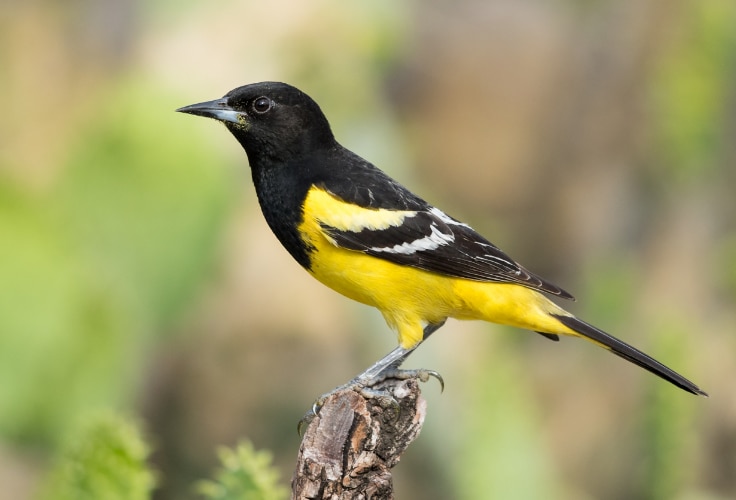
Scott’s oriole is the desert specialist of the oriole family, frequently associated with yucca-studded hillsides and arid mountain slopes. Its striking coloration and loud, frequent song make it a prominent feature of the desert soundscape. Measuring 20-23 centimeters (7.9-9.1 inches), it is a medium-sized oriole with a relatively slender bill and long tail.
Adult males are distinctive, with a black hood, back, and breast set against lemon-yellow underparts, rump, and shoulders. The wings are black with a bold white wingbar and a yellow epaulet. The tail shows a mix of black and yellow, with outer feathers largely yellow. Females are variable, usually olive-gray above and yellow below, with scattered black on the head or throat. Young birds are duller and streaked, with immature males resembling females until they gradually acquire adult plumage.
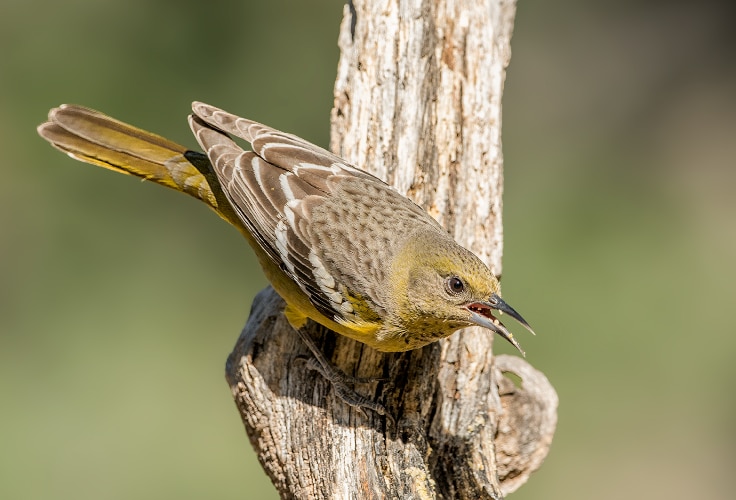
Scott’s orioles forage by hopping and climbing among shrubs and yuccas, probing flowers, leaves, and dead foliage for insects, nectar, and fruit. They sometimes descend to the ground or feed at hummingbird feeders, and are even known to prey on monarch butterflies at their wintering colonies in Mexico. Their flight is low and somewhat undulating. Males sing persistent, rapid whistles reminiscent of a meadowlark, and both sexes may sing back and forth early in the nesting season. Courtship involves aerial pursuits, display flights, and ground waddling displays by males.
The species breeds across the southwestern United States, from California, Nevada, Utah, Arizona, New Mexico, and western Texas, south through much of Mexico, including Baja California and the central highlands. It prefers arid foothills, desert-facing slopes, pinyon-juniper woodlands, and areas with abundant yuccas, which often serve as nest sites. Nests are placed in yucca crowns or other tall desert vegetation. In winter, most individuals migrate to central and southern Mexico, though small numbers remain in the southwestern U.S.
Although still fairly common in much of its range, Scott’s oriole populations have shown gradual declines over recent decades, averaging close to 1% annually. Habitat loss and degradation in both breeding and wintering areas are the primary threats, particularly as desert and foothill landscapes face development, overgrazing, and vegetation changes. Despite these pressures, the species remains widespread and secure overall, though continued monitoring is needed to ensure its long-term stability in fragile desert ecosystems.
Audubon’s Oriole
Icterus graduacauda
- Identification: Medium to large oriole; yellow body with black head, wings, and tail, back washed olive.
- Where found: Resident in northeastern Mexico and extreme southern Texas; also occurs across much of central and western Mexico.
- How to spot: Look for its yellow body and black hood in dense woodlands; listen for its slow, mellow series of whistled notes.
- Conservation status: Least Concern globally, but rare and local in the U.S., where small populations face threats from habitat loss and cowbird parasitism.

Audubon’s oriole is the only oriole in the United States that is a year-round resident, but its U.S. range is limited to the brushlands and riparian corridors of southern Texas. Elsewhere it is widespread in Mexico, inhabiting a variety of wooded habitats. At 19-24 centimeters (7.5-9.4 inches), it is medium to large among orioles, with a sturdy build and straight bill.
Both sexes look similar, making it one of the few orioles in North America without obvious sexual dimorphism. Adults are striking, with a lemon-yellow body, black head, wings, and tail, and an olive-toned back and rump. Some populations show white wingbars, while others lack them. Females are generally duller, and juveniles appear mostly olive and yellow without the black hood, which develops within a few months of fledging.
Unlike many other orioles, Audubon’s is more secretive, often keeping to dense foliage rather than perching conspicuously. Its song is distinctive: a slow, mellow series of pure whistles, lower-pitched and more leisurely than the rich fluting of Baltimore or Bullock’s orioles. Both males and females sing, often in duet, and pairs maintain close contact throughout nesting. Foraging is deliberate, involving climbing and hopping through foliage, probing for insects, spiders, fruit, and seeds. They also visit feeders for sunflower seeds or fruit.
This species is found year-round in northeastern Mexico and into southern Texas, as well as across much of central and western Mexico, from Nayarit and Jalisco to Veracruz and Oaxaca. In Texas, it inhabits thorn forest, riparian woods, and live oak groves, often nesting in mesquites, willows, and hackberries. In Mexico, it occupies a wide range of forest types, including tropical, pine-oak, and cloud forests. Nests are placed in trees or tall shrubs, usually suspended over clearings, fields, or waterways. Unlike many orioles, pairs often remain together year-round and may join small mixed flocks outside the breeding season.
Globally, Audubon’s oriole is secure, but its U.S. population is small, fragmented, and vulnerable. Fewer than 5,000 are thought to breed in Texas, and the species has disappeared from some areas where it was once common. Loss and fragmentation of thorn forest, combined with heavy brood parasitism by cowbirds, pose significant threats in the U.S. While stable in much of Mexico, the northernmost populations are of special concern, and continued conservation of riparian and thorn woodlands will be key to its persistence.
Altamira Oriole
Icterus gularis
- Identification: Large oriole; adults bright orange with black throat, face, back, wings, and tail, plus bold white wingbar and orange shoulder patch.
- Where found: Resident from the lower Rio Grande Valley of Texas south through eastern and southern Mexico and into parts of Central America.
- How to spot: Look for its large size and vivid orange plumage in tall isolated trees or along riparian edges; listen for slow, sweet whistles.
- Conservation status: Least Concern globally, but rare and local in the U.S., where populations are small and vulnerable to habitat loss and cowbird parasitism.
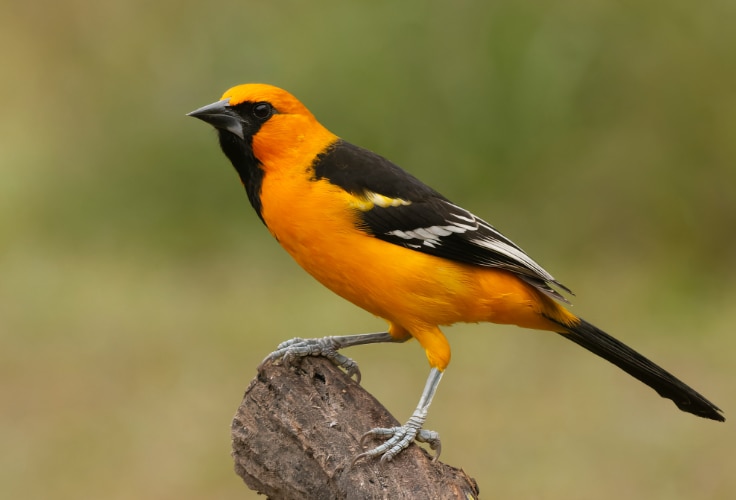
The Altamira oriole is the largest oriole in the United States and a resident species of the Lower Rio Grande Valley in Texas, where it is highly sought after by birders. It measures 21-25 centimeters (8.3-9.8 inches) and has a heavier, thicker bill than most of its relatives.
Both sexes share the same striking plumage: brilliant orange head and underparts, contrasting with a black throat, lores, back, wings, and tail. The wings show a broad white bar and orange shoulder patch, while the tail is entirely black. Juveniles are duller, yellow-olive with less black, and first-year birds resemble adults but are paler overall with less wing contrast.
Altamira orioles are often conspicuous, perching in exposed locations and flying between trees with quick, jerky movements. Their song is a series of slow, sweet whistles, sometimes interspersed with harsher notes, described as deliberate and human-like in tone. Contact calls include nasal ike notes and rattling chatters. Pairs often remain together throughout the year, keeping in touch with soft calls while foraging.
Unlike most orioles in North America, the Altamira is nonmigratory, remaining year-round from the lower Rio Grande Valley of Texas through eastern and southern Mexico, including the Yucatan and Cozumel, and south to Belize, Guatemala, Honduras, and western-central Nicaragua. It inhabits semi-arid woodlands, riparian edges, thorn forest, and forest clearings with scattered tall trees. Nests are long, hanging pouches placed high on exposed branches or, in Texas, sometimes on telephone wires or over open ground and water. The species adapts to human presence and may use rural yards near suitable habitat.
Although considered secure in its broader Mexican and Central American range, the Altamira oriole is scarce in the United States, with no more than a few hundred breeding pairs confined to the lower Rio Grande Valley. Habitat loss and fragmentation, as well as brood parasitism by cowbirds, are the main threats. Conservation of thorn forest and riparian woodlands in Texas is essential to sustain this small but iconic U.S. population.
Spot-Breasted Oriole
Icterus pectoralis
- Identification: Large oriole; bright orange body with black face, throat, back, wings, and tail; distinctive black spots on the breast.
- Where found: Native to southern Mexico and Central America; introduced and established in southern Florida.
- How to spot: Look for its bold breast spots and listen for slow, rich whistles; often seen in pairs or family groups in semi-open woodlands.
- Conservation status: Least Concern globally; Florida population stable, though introduced.

The spot-breasted oriole is one of the few orioles in North America that is not native to the United States. It was introduced to southern Florida in the late 1940s, likely from escaped cage birds, and has since become a regular suburban nester in the Miami area. It measures 21-24 centimeters (8.3-9.4 inches) and has a heavier, slightly curved bill compared to many of its relatives.
Adults are striking, with a pale orange to deep orange body, black face, throat, mantle, back, wings, and tail, and a distinctive pattern of black spots across the breast. Lesser and median wing coverts are orange-yellow, while the closed wing shows bold white patches. Females are similar but slightly duller, while juveniles are yellower, lack the black facial mask and breast spots, and have more olive tones.
The species can be detected by its slow series of clear, mellow whistles, often delivered by both sexes. Its calls include loud nasal notes and sharp, chattering tones. Spot-breasted orioles often forage quietly in pairs or family groups, gleaning insects from foliage, prying open rolled leaves, and visiting flowers for nectar. They are sometimes seen alongside other orioles in mixed flocks.
Across its native range from southern Mexico to northwestern Costa Rica, the spot-breasted oriole inhabits tropical semi-open habitats, arid thorn scrub, acacia and mesquite woodlands, forest edges, shade coffee, and ranchlands, generally below 900 meters (3,000 feet). In Florida, the species is confined to the Miami area and nearby counties, where it thrives in suburban neighborhoods with large trees, parks, and gardens. Nests are long, hanging pouches woven from plant fibers and epiphyte roots, suspended from exposed branch forks.
The spot-breasted oriole remains fairly common across much of its native range, though it tends to be less abundant than other orioles sharing the same habitats. The Florida population, though small, has remained stable since its introduction, showing tolerance for human-modified environments. Across its range, the species adapts well to disturbed landscapes, though it is generally less abundant than other orioles in the same habitats.
Streak-Backed Oriole
Icterus pustulatus
- Identification: Medium-sized oriole; orange head and underparts with black throat patch and streaked black-and-orange back; white wing patches prominent.
- Where found: Native to western Mexico south into Central America; rare visitor to the southwestern United States.
- How to spot: Look for its streaked back and bold throat patch; often sings a series of melodic whistles and forages in pairs or small groups.
- Conservation status: Least Concern globally; populations generally stable, though some insular races may be vulnerable.
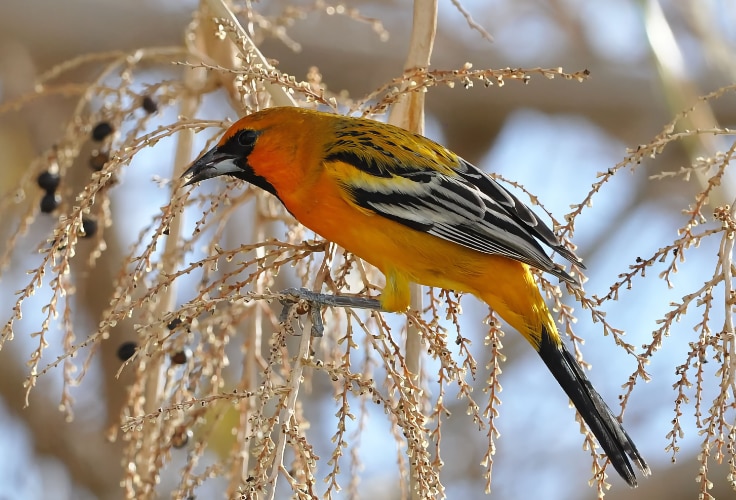
The streak-backed oriole is a striking Pacific-slope species, best known for its unusual black-streaked back – a feature not seen in most other orioles. Occasionally reaching the southwestern United States, it once bred in Arizona in the 1990s, making it a sought-after rarity for birders. Measuring 19-21 centimeters (7.5-8.3 inches), it is slightly larger and bulkier than the hooded oriole, with a straighter bill and more extensive white on the wings.
Adults are deep orange on the head and underparts, with a black throat and contrasting dark streaks on the back. The wings are mostly black, marked with bright white patches and edgings. Females are similar but somewhat duller, while juveniles are yellowish with faint or absent streaking and lack the dark facial markings. Geographic variation is considerable, with northern birds often brighter and less streaked, and southern forms heavier-marked and sometimes nearly black-backed.
Its song is a rich, melodic series of whistles reminiscent of a vireo, sometimes interspersed with harsh churrs. Both sexes sing, though males more frequently. Calls include sharp chit notes and chatters. When foraging, the species gleans insects from foliage, probes rolled leaves, extracts larvae from rotting wood, and also feeds on nectar and fruits. Foraging is typically in pairs or family groups, though small parties may form outside the breeding season.
The species is widespread from western Mexico through Central America, occurring in tropical woodlands, thorn scrub, plantations, savannas, and even village trees, mostly below 500 meters (1,600 feet) but locally up to 2,000 meters (6,600 feet) in the south. In the United States it is a rare visitor to Arizona, New Mexico, and occasionally California and Texas, with breeding confirmed in Arizona in 1993. Nests are long hanging pouches woven from plant fibers, sometimes placed near wasp nests or in thorny acacias that host protective ants.
The streak-backed oriole is common to locally abundant in much of its range and adapts readily to semi-open and human-modified habitats. While most populations are stable, small insular forms such as the Tres Marias race are considered vulnerable because of their restricted ranges.
Black-Vented Oriole
Icterus wagleri
- Identification: Slim black-and-yellow oriole, black head and back with orange-yellow underparts and a dark vent.
- Where found: Highlands and interior regions of Mexico south to Nicaragua; rare visitor to Texas and Arizona.
- How to spot: Look for a long, slightly downcurved bill, solid black upperparts, and bright yellow-orange body.
- Conservation status: Least Concern globally; stable populations but some local declines due to habitat change.
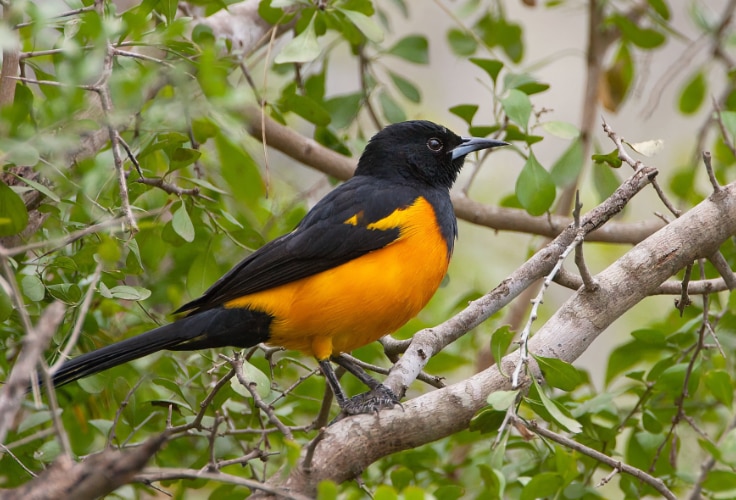
The black-vented oriole is an attractive but inconspicuous species of Mexico and Central America, only occasionally wandering into the United States. Rare records in Texas and Arizona make it a sought-after vagrant for birders. It measures 20-23 centimeters (7.9-9.1 inches) and is slim-bodied with a slightly downcurved bill, giving it a distinctive profile among orioles.
Adults are mostly black above, including the head, back, wings, and tail, with contrasting orange-yellow underparts and a darker vent area. Males and females look similar, although females are slightly duller, leaning more toward yellow than orange. Juveniles are much paler, with olive upperparts and dull yellow below, lacking the crisp contrast of adults.
The species is usually seen in pairs or small family groups, foraging quietly in mid-level foliage or visiting flowering trees. It gleans insects and larvae from leaves and branches, supplements its diet with fruit, and regularly takes nectar, where it can be dominant over other orioles. Its song is a melodic series of whistles, often mixed with sharper calls.
It inhabits dry woodlands, scrubby slopes, and semiopen areas with scattered tall trees, ranging from 500 to 2,500 meters (1,600-8,200 feet) in elevation. At times it occurs in flowering coconut groves or agave stands, moving locally or seasonally in response to blooming trees. In the U.S., accidental records suggest occasional wandering or partial migration.
The black-vented oriole remains common through much of its range, showing flexibility in habitat use and tolerance of modified landscapes. While not considered threatened, local populations depend on the availability of flowering trees and wooded edges, which provide both food and nesting sites.
Orioles in the North American Landscape
Orioles bring a burst of color and song to North America, from the familiar Baltimore oriole of eastern backyards to the brilliant Altamira and rarer tropical vagrants of the Southwest. Though they differ in size, plumage, and range, all orioles share an affinity for nectar, fruit, and insects, playing important roles as pollinators and insect controllers.
Their presence reflects both the seasonal rhythms of migration and the year-round richness of the southern borderlands. For birders, orioles are among the most rewarding species to watch – bright, active, and often surprisingly approachable. Protecting the woodlands, groves, and suburban trees they depend on ensures that these striking birds will remain a vibrant part of North America’s avian diversity for generations to come.



